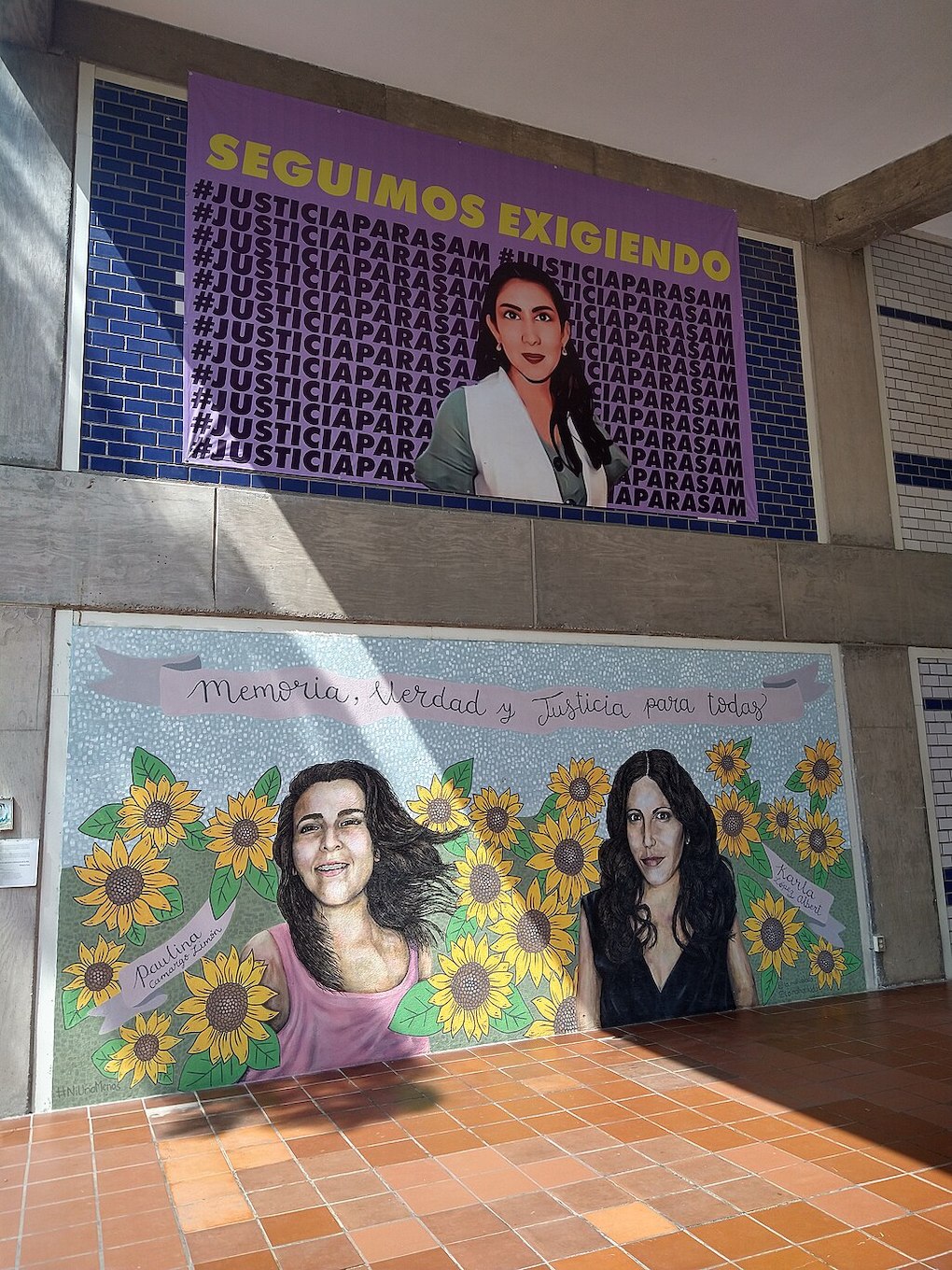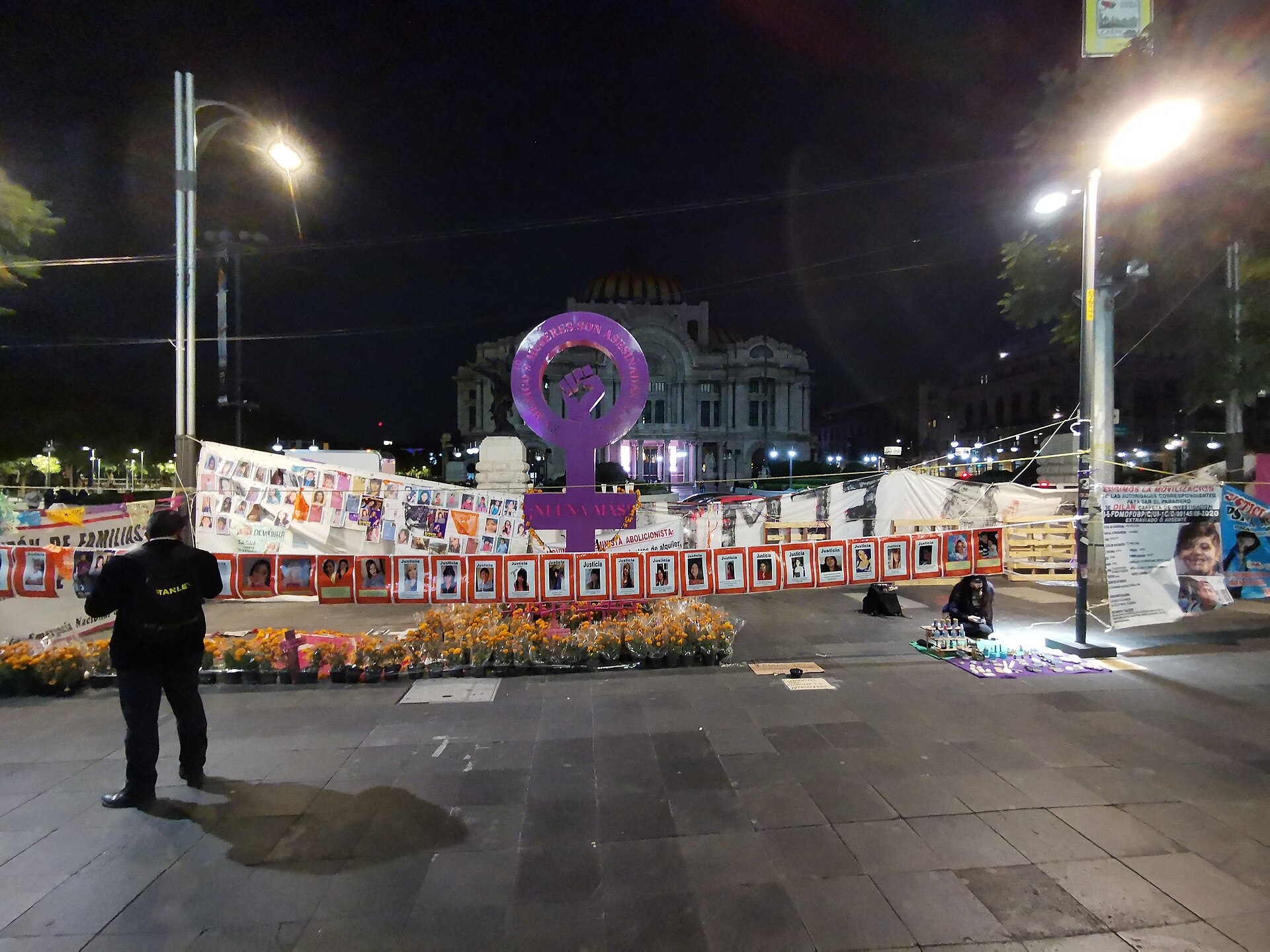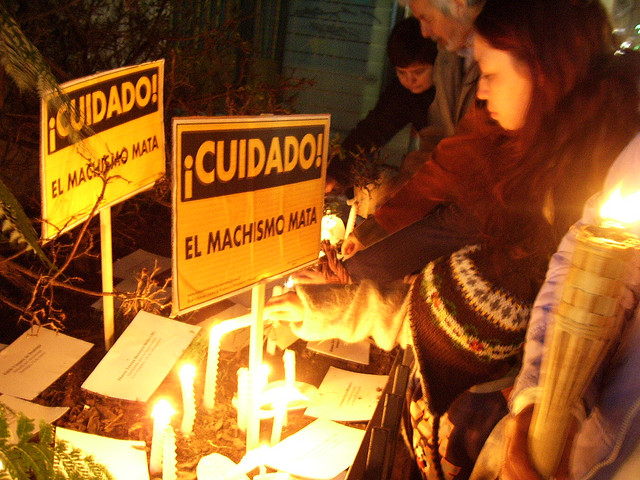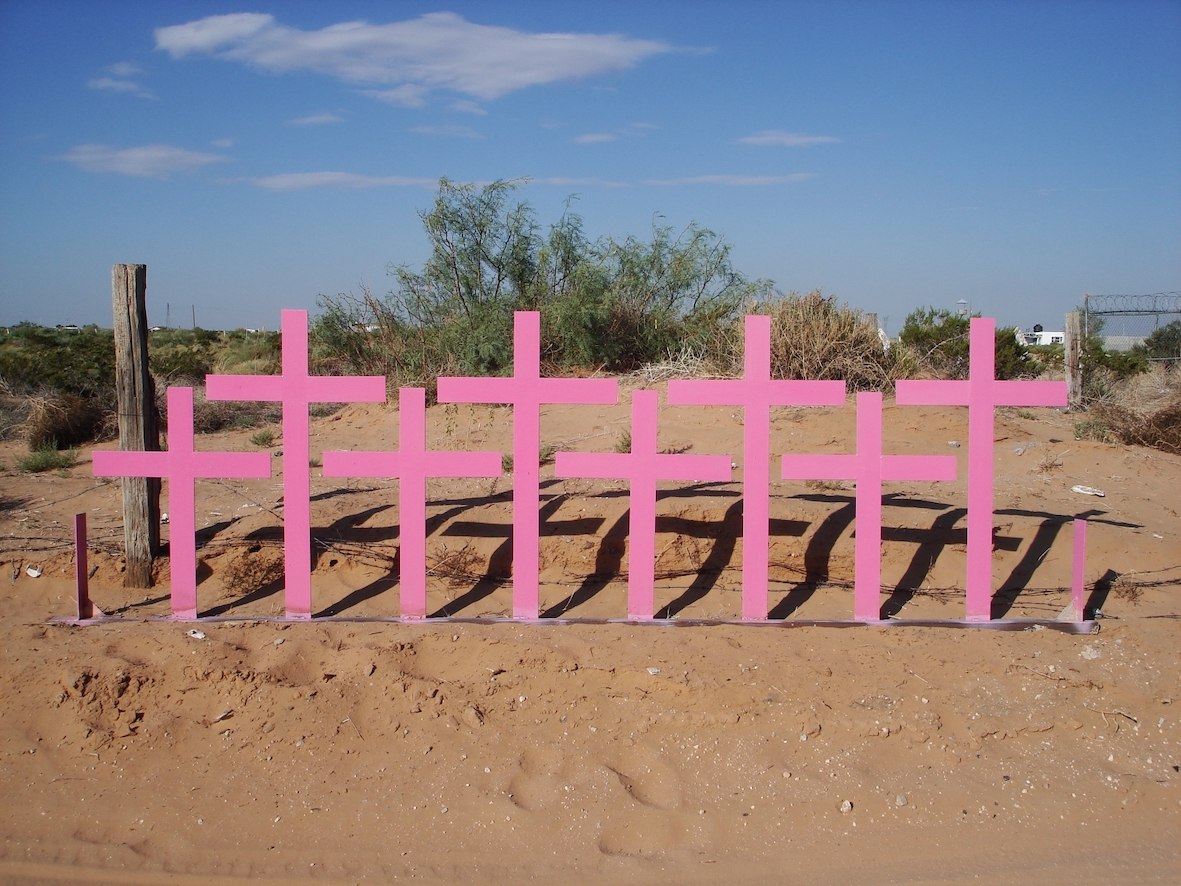
ラテンアメリカにおけるフェミサイド
Femicide in Latin America
Murals
in Mexico dedicated to memorializing three victims of femicide: Paulina
Camargo, Karla López y Samantha Rosales.
☆ フェミサイド(femicide)またはフェミニサイド(feminicide)とは、女性や女児がその性別を理由に意図的に殺害されることである。フェミサイド(Femicide in Latin America) は、ラテンアメリカで広く蔓延している問題である[1][2]。 2016年、世界的にフェミサイドの発生率が最も高い上位25カ国のうち14カ国がラテンアメリカまたはカリブ海諸国であった[1]。2021年には、こ の地域で4,445人の女性がフェミサイドの犠牲となったと記録されており、ラテンアメリカでは約2時間に1人の女性がジェンダーに基づく殺人を犯してい ることになる[2][3]。 2010年代を通じて、ラテンアメリカ諸国政府は、フェミサイドという犯罪を法的に認識し、区別し始めた[4][5][6]。これと、国連ラテンアメリ カ・カリブ海経済委員会(ECLAC)が多くの国家に提供した記録収集支援とが相まって、ラテンアメリカ諸国は、地域全体のフェミサイド率に関するより包 括的なデータを作成することができるようになった[2]。ラテンアメリカの10カ国は、ジェンダー関連の暴力に関するデータの収集を命じる法律を制定して おり、2022年現在、GEOのデータを用いてフェミサイドが行われている[7]。 改革の努力にもかかわらず、ラテンアメリカの女性殺人の割合は近年大幅に減少しておらず、女性殺人の総数は2020年の4,091人から2021年には 4,445人に増加している[2][8]。ラテンアメリカの女性殺人の割合が高い背景には、定着したジェンダー役割とマチスモの存続、組織犯罪と犯罪統 治、ジェンダーに基づく犯罪を不処罰で扱う脆弱な司法制度など、一連の要因がある。[ラテンアメリカ各地の活動家やフェミニストグループは、高いフェミサ イドの割合と、女性に対する暴力に対処できない国家の共犯性に抗議する運動を作り上げてきた。[4]支持を得た運動の中には、シウダー・フアレスの「消え る娘たち」プロジェクトやアルゼンチン発祥の「Ni Una Menos」運動がある[12]。ピンクの十字架は、ラテンアメリカ全域で女性殺人の犠牲者を追悼するために使用されている[13]。
| Femicide in Latin America Femicide, broadly defined as the murder of a woman motivated by gender, is a prevalent issue in Latin America.[1][2] In 2016, 14 of the top 25 nations with the highest global femicide rates were Latin American or Caribbean states.[1] In 2021, 4,445 women were recorded victims of femicide in the region, translating to the gender-based murder of about one woman every two hours in Latin America.[2][3] Throughout the 2010s, Latin American governments began legally recognizing and distinguishing the crime of femicide.[4][5][6] This, coupled with records collection support provided to many states by the United Nations Economic Commission for Latin America and the Caribbean (ECLAC), has allowed Latin American nations to produce more comprehensive data on femicide rates across the region.[2] Ten Latin American countries have laws ordering the collection of data on gender-related violence, and femicide as of 2022 with the GEO's data.[7]  Murals in Mexico dedicated to memorializing three victims of femicide: Paulina Camargo, Karla López y Samantha Rosales. Despite efforts to reform, Latin American femicide rates have not decreased substantially in recent years, with the total number of femicides increasing from 4,091 2020 to 4,445 in 2021.[2][8] A series of factors account for high rates of femicide in Latin America, including entrenched gender roles and the persistence of machismo, organized crime and criminal governance, and weak justice institutions that treat gender-based crimes with impunity.[9][10][11] The impacts of femicide include violation of basic human rights, displacement of women, and amplification of organized crime and ineffective justice systems.[7] Activists and feminist groups across Latin America have created movements protesting high rates of femicide and state complicity in failing to address violence against women.[4] Some of the movements that have gained traction are the "Disappearing Daughters" project in Ciudad Juarez and the "Ni Una Menos" movement originating in Argentina.[12] Pink crosses are used to commemorate victims of femicide throughout Latin America.[13] |
ラテンアメリカにおけるフェミサイド フェミサイドは、広義にはジェンダーを動機とする女性の殺人と定義さ れ、ラテンアメリカで広く蔓延している問題である[1][2]。 2016年、世界的にフェミサイドの発生率が最も高い上位25カ国のうち14カ国がラテンアメリカまたはカリブ海諸国であった[1]。2021年には、こ の地域で4,445人の女性がフェミサイドの犠牲となったと記録されており、ラテンアメリカでは約2時間に1人の女性がジェンダーに基づく殺人を犯してい ることになる[2][3]。 2010年代を通じて、ラテンアメリカ諸国政府は、フェミサイドという犯罪を法的に認識し、区別し始めた[4][5][6]。これと、国連ラテンアメリ カ・カリブ海経済委員会(ECLAC)が多くの国家に提供した記録収集支援とが相まって、ラテンアメリカ諸国は、地域全体のフェミサイド率に関するより包 括的なデータを作成することができるようになった[2]。 ラテンアメリカの10カ国は、ジェンダー関連の暴力に関するデータの収集を命じる法律を制定しており、2022年現在、GEOのデータを用いてフェミサイ ドが行われている[7]。  メキシコの壁画は、3人の女性殺人の犠牲者の追悼に捧げられている: パウリナ・カマルゴ、カルラ・ロペス、サマンサ・ロサレス。 改革の努力にもかかわらず、ラテンアメリカの女性殺人の割合は近年大幅に減少しておらず、女性殺人の総数は2020年の4,091人から2021年には 4,445人に増加している[2][8]。ラテンアメリカの女性殺人の割合が高い背景には、定着したジェンダー役割とマチスモの存続、組織犯罪と犯罪統 治、ジェンダーに基づく犯罪を不処罰で扱う脆弱な司法制度など、一連の要因がある。[ラテンアメリカ各地の活動家やフェミニストグループは、高いフェミサ イドの割合と、女性に対する暴力に対処できない国家の共犯性に抗議する運動を作り上げてきた。[4]支持を得た運動の中には、シウダー・フアレスの「消え る娘たち」プロジェクトやアルゼンチン発祥の「Ni Una Menos」運動がある[12]。ピンクの十字架は、ラテンアメリカ全域で女性殺人の犠牲者を追悼するために使用されている[13]。 |
| Incidence Every year, the Gender Equality Observatory (GEO) of the United Nations Economic Commission for Latin America and the Caribbean (ECLAC) publishes a report of the national femicide rates provided by Latin American and Caribbean nations and territories for the previous year.[14] In 2021, 4,445 women were recorded victims of femicide or gender-related killing in the 18 Latin American nations and territories that reported their data to the GEO.[15] The Wilson Center estimates that this rate translates to women in Latin America dying every two hours due to femicide.[3] According to the GEO's data for 2021, Brazil reported the highest raw number of femicides at 1,900 women murdered, while Puerto Rico reported the lowest raw number at 12 women murdered.[15] However, Puerto Rico's rate may be impacted by the fact that it only records instances of femicide that are specifically perpetrated against women by their intimate partners - the same stipulation is true of Nicaragua, which reported 15 femicides in 2021.[15] The different trends regarding femicide across the countries in Latin America show that factors such as machismo, organized crime, and gender roles have roles of varying severity in each country.[7] Highest rates of femicide Honduras, the Dominican Republic, El Salvador, Bolivia, and Brazil reported the highest rates of femicide across the region respectively in 2021.[16] In Honduras, 4.6 women per 100,000 were the victims of femicide.[16] In the Dominican Republic, 2.7 women per 100,000 were the victims of femicide.[16] In El Salvador, 2.4 women per 100,000 were the victims of femicide.[16] In Bolivia, 1.8 women per 100,000 were the victims of femicide.[16] Finally, in Brazil, 1.7 women per 100,000 were the victims of femicide.[16] Lowest rates of femicide Nicaragua, Chile, Puerto Rico, Costa Rica, and Peru reported the lowest rates of femicide across Latin America in 2021.[16] In Nicaragua, 0.4 women per 100,000 were the victims of femicide.[16] In Chile, 0.5 women per 100,000 were the victims of femicide. In both Costa Rica and Puerto Rico, 0.7 women per 100,000 were the victims of femicide.[16] In Peru, 0.8 women per 100,000 were the victims of femicide.[16] Femicide rates over time ECLAC has compiled data on the change in rates of femicide across Latin American nations and territories over time. Despite recent efforts to reduce gender-based violence in the region, there was no significant decline in rates of femicide across Latin America from 2019 to 2021.[16] Some nations have recorded a small drop in femicide rates in recent years. In Honduras, for example, the femicide rate dropped from 6.0 female victims per 100,000 in 2019 to 4.5 female victims per 100,000 in 2020 - before increasing slightly to 4.6 female victims per 100,000 in 2021.[16] Other nations have recorded an increase in femicide rates over the observed period. In Mexico, for example, the femicide rate increased from 1.5 female victims per 100,000 in 2019 and 2020 to 1.6 female victims per 100,000 in 2021.[16] |
発生率 毎年、国連ラテンアメリカ・カリブ海経済委員会(ECLAC)のジェンダー平等監視団(GEO)は、ラテンアメリカとカリブ海の国・地域から提供された前 年の国民ナショナリズム率の報告書を公表している。[14] 2021年には、GEOにデータを報告したラテンアメリカの18の国と地域で、4,445人の女性がフェミサイドまたはジェンダーに関連した殺害の犠牲と なったと記録されている[15]。ウィルソン・センターは、この割合はラテンアメリカの女性がフェミサイドによって2時間ごとに死亡していることになると 推定している[3]。 GEOの2021年のデータによると、ブラジルは殺害された女性の数が1,900人と最も多く、一方、プエルトリコは殺害された女性の数が12人と最も少 なかった。[15]しかし、プエルトリコの割合は、特に親密なパートナーによる女性に対するフェミサイドの事例のみを記録しているという事実によって影響 を受けている可能性がある。[15]ラテンアメリカの国々におけるフェミサイドに関する異なる傾向は、マチスモ、組織犯罪、ジェンダー役割などの要因が、 各国でさまざまな深刻さの役割を担っていることを示している[7]。 最も高い女性殺人の割合 ホンジュラス、ドミニカ共和国、エルサルバドル、ボリビア、ブラジルは、2021年にそれぞれこの地域で最も高い女性殺人の割合を報告した[16]。ホン ジュラスでは、10万人当たり4.6人の女性が女性殺人の犠牲となった[16]。ボリビアでは、10万人当たり1.8人の女性がフェミサイドの犠牲となっ た[16]。最後にブラジルでは、10万人当たり1.7人の女性がフェミサイドの犠牲となった[16]。 最も低い女性殺人の割合 ニカラグア、チリ、プエルトリコ、コスタリカ、ペルーでは、2021年にラテンアメリカ全体で最も低い女性殺人の割合が報告された[16]。ニカラグアで は、10万人当たり0.4人の女性が女性殺人の犠牲となった[16]。コスタリカとプエルトリコでは、10万人当たり0.7人の女性が女性殺人の犠牲者で あった[16]。 ペルーでは、10万人当たり0.8人の女性が女性殺人の犠牲者であった[16]。 時系列での女性殺人の割合 ECLACは、ラテンアメリカのナショナリズムの国や地域におけるフェミサイドの割合の経年変化に関するデータをまとめた。この地域におけるジェンダーに 基づく暴力を減らすための最近の取り組みにもかかわらず、2019年から2021年にかけて、ラテンアメリカ全体でフェミサイドの割合に大きな減少は見ら れなかった[16]。 近年、フェミサイドの割合がわずかに低下したことを記録している国民もいる。例えばホンジュラスでは、女性殺害率は2019年の10万人当たり6.0人か ら2020年には4.5人に減少し、その後2021年には10万人当たり4.6人にわずかに増加した[16]。例えばメキシコでは、女性殺害率は2019 年と2020年の10万人当たり1.5人から、2021年には10万人当たり1.6人に増加した[16]。 |
| Femicide rates by relationship to perpetrator Globally, the largest perpetrators of femicide are women's intimate partners - both current and past partners.[17] In Latin America, however, data on the connection between femicide and the victim's relationship to the offender is less cohesive. For some nations, the vast majority of femicides are committed by former or current intimate partners. In 2021, Argentina, Uruguay, Peru, Ecuador, Paraguay, and Chile all recorded that women were murdered by former or current intimate partners in over 70% of femicide cases.[16] Specifically, these intimate partner femicides accounted for 93% of Chile's reported gender-based murders of women.[16] In Uruguay, 1.1 women per 100,000 were the victims of femicide by intimate partners in 2021.[16] An important consideration to make is that certain Latin American countries like El Salvador and Uruguay do not characterize intimate partner violence or femicide as a crime, which can underestimate the incidence of femicide in these countries.[18] By contrast, for other nations, intimate partner femicides account for the minority of gender-based murders of women. In both El Salvador and Honduras, 25% or less of recorded femicides in 2021 were committed by past or current intimate partners.[16] This is thought to be due to a larger presence of organized crime and violence in society that accounts for a larger portion of femicides, with women being killed by strangers and gang members.[7] Femicide rates and migration According to qualitative studies, high migration flow across Latin America likely contributes to increased rates of femicide.[16] Migrant women are particularly vulnerable to gender-based killing and violence as a result of contextual issues like deficient support systems, discrimination, social stigma, insecurity of legal status, and language barriers in Latin America.[16][19] Furthermore, many women are traveling alone without company or protection against the gender-based crimes they could become victims of.[20] However, a limited number of Latin American nations and territories have recorded data on the nationality or migratory status of the victims of femicide. In 2021, foreign women were murdered in 18% of recorded femicides in Chile.[16] In the Dominican Republic, foreign women were the victims in 13% of recorded femicides. Finally, in Costa Rica, foreign women accounted for 11% of recorded femicides.[16] According to ECLAC, these three Latin American nations have experienced high rates of migration and migratory flow in recent years - potentially indicating a relationship between female migration and femicide.[16] The North Triangle of Central America (NTCA) consists of El Salvador, Guatemala, and Honduras and also experiences high rates of emigration and migratory flow.[20] This is due to a lack of safety for women in these countries. which have very high rates of gender-based violence.[20] However, according to 2017 data from Medecins Sans Frontieres (MSF), close to one third of women who passed through Mexico while migrating were sexually abused.[20] The perpetrators include individuals, gangs, and law enforcement, which have been reported to abuse their authority to take advantage of the migrants.[20] |
加害者との関係別のフェミサイド率 世界的に見て、フェムサイドの最大の加害者は、女性の親密なパートナー(現在のパートナーも過去のパートナーも)である[17]。しかし、ラテンアメリカでは、フェムサイドと被害者と加害者の関係との関連に関するデータはあまりまとまっていない。 ナショナリズムの国によっては、女性殺人の大多数が元または現在の親密なパートナーによるものである。2021年、アルゼンチン、ウルグアイ、ペルー、エ クアドル、パラグアイ、チリはいずれも、フェムサイド事件の70%以上において、女性が元または現在の親密なパートナーによって殺害されたと記録している [16]。特に、これらの親密なパートナーによるフェムサイドは、チリで報告されたジェンダーに基づく女性殺害事件の93%を占めていた[16]。16] 考慮すべき重要な点は、エルサルバドルやウルグアイのような特定のラテンアメリカ諸国は、親密なパートナーからの暴力やフェミサイドを犯罪として特徴づけ ていないため、これらの国におけるフェミサイドの発生率が過小評価される可能性があるということである[18]。 対照的に、他の国民にとっては、親密なパートナーによるフェミサイドは、ジェンダーに基づく女性の殺人の少数派を占めている。エルサルバドルでもホンジュ ラスでも、2021年に記録された女性殺人のうち、過去または現在の親密なパートナーによるものは25%以下であった[16]。これは、女性殺人の大部分 を占める社会における組織犯罪や暴力の存在が大きく、女性が見知らぬ人やギャングのメンバーによって殺されるためであると考えられている[7]。 女性殺人の割合と移住 質的研究によると、ラテンアメリカ全域にわたる高い移民の流れが、フェミサイドの割合増加の一因となっている可能性が高い[16]。 移住女性は、ラテンアメリカにおける不十分な支援制度、差別、社会的烙印、法的地位の不安定さ、言語の障壁といった文脈上の問題の結果として、ジェンダー に基づく殺害や暴力に対して特に脆弱である[16][19]。さらに、多くの女性は、仲間もなく、ジェンダーに基づく犯罪の被害者になる可能性から保護さ れることもなく、一人で旅行している[20]。 しかし、ラテンアメリカの限られた国や地域が、女性殺人の被害者のナショナリズムや移住の状況に関するデータを記録している。2021年、チリでは、記録 された女性殺人の18%で外国人女性が殺害されていた[16]。 ドミニカ共和国では、記録された女性殺人の13%で外国人女性が被害者であった。最後に、コスタリカでは、記録された女性殺人の11%が外国人女性であっ た[16]。 ECLACによれば、これらラテンアメリカの3国民は、近年、高い割合の移住と移動の流れを経験しており、女性の移住と女性殺人の関係を潜在的に示してい る[16]。 中米の北三角地帯(NTCA)は、エルサルバドル、グアテマラ、ホンジュラスで構成され、移住と移動の割合も高い[20]。[20] しかしながら、国境なき医師団(MSF)の2017年のデータによれば、移住中にメキシコを通過した女性の3分の1近くが性的虐待を受けている[20]。 加害者には、個人、ギャング、法執行機関が含まれ、移民を利用するために権限を乱用することが報告されている[20]。 |
| Femicide rates and age According to data collected from 2019 to 2021 from the Gender Equality Observatory, the greatest incidence of femicide occurs in victims aged 15 to 29.[7] The impacts of femicide start for girls at a young age, with over 4% of femicides regarding girls aged 14 or younger.[7] This data shows a negative correlation between age and incidence of femicide.[7] There is also a high rate of Child marriage that disproportionately impacts girls and young women in Latin America, compared to young men, predisposing them to be more vulnerable to gender-based violence.[7] Data from the GEO has shown that child marriage increases the likelihood of girls and women to be victims of intimate partner violence and femicide.[7][21] Data collection concerns Accurate and comprehensive data collection on crime and violence in Latin America poses significant challenges.[16] In the context of gender-based killings, public and private organizations similarly have struggled to aggregate quality data on rates of femicide and relevant contextual factors in Latin American countries.[22][23] Instances of violence against women and femicide are often underreported, and many nations fail to include intersectional variables like race, ethnicity, migrant status, pregnancy, or sexual orientation in data on femicide victims.[16][22][23][8] Recorded femicide rates are also impacted by definitional differences across the region. For example, both Puerto Rico and Nicaragua, with some of the lowest recorded rates of femicide in Latin America, only report intimate partner femicide to the Gender Equality Observatory - excluding gender-based killings committed by other types of offenders.[16] However, many nations are making efforts to address issues of incomplete and under-reported data on violence against women. Ten Latin American states have recently passed laws requiring the collection and circulation of data and information on femicide and other crimes of violence against women.[16] Many countries have updated their definitions, indicators, and investigation methods in the context of femicide in recent years - resulting in corrected and more complete data on historical incidences of gender-based killings.[16] ECLAC has continued to support Latin American nations in expanding and enhancing their records and data collection on femicide rates.[16] |
フェミサイドの発生率と年齢 ジェンダー平等監視団が2019年から2021年にかけて収集したデータによると、フェムサイドの発生率が最も高いのは15歳から29歳の被害者である[7]。このデータは、年齢とフェムサイドの発生率の間に負の相関関係があることを示している[7]。 また、ラテンアメリカでは、若い男性に比べて少女や若い女性に不釣り合いな影響を与える児童婚の割合が高く、ジェンダーに基づく暴力を受けやすい素地があ る[7]。GEOのデータは、児童婚が少女や女性が親密なパートナーからの暴力やフェミサイドの被害者になる可能性を高めることを示している[7] [21]。 データ収集に関する懸念 ラテンアメリカにおける犯罪と暴力に関する正確で包括的なデータ収集は、重大な課題を提起している[16]。ジェンダーに基づく殺人の文脈では、公的機関 も民間機関も同様に、ラテンアメリカ諸国におけるフェミサイドの割合と関連する文脈的要因に関する質の高いデータを集約するのに苦労している。[22] [23]女性に対する暴力やフェミサイドの事例が過小報告されることが多く、多くの国民がフェミサイド被害者のデータに人種、民族、移民の地位、妊娠、性 的指向のような交差的変数を含めていない[16][22][23][8]。記録されたフェミサイド率は、地域間の定義の違いによっても影響を受ける。例え ば、ラテンアメリカでフェミサイドの記録率が最も低いプエルト・リコとニカラグアは、ジェンダー平等展望台に親密なパートナーによるフェミサイドのみを報 告しており、他のタイプの犯罪者によるジェンダーに基づく殺人は除外されている[16]。 しかし、多くの国民が、女性に対する暴力に関する不完全で過少報告なデータの問題に取り組む努力をしている。ラテンアメリカの10州は最近、フェミサイド やその他の女性に対する暴力犯罪に関するデータと情報の収集・流通を義務付ける法律を可決した[16]。多くの国民が近年、フェミサイドに関する定義、指 標、調査方法を更新し、その結果、ジェンダーに基づく殺人の過去の発生件数に関するデータが修正され、より完全なものになった[16]。ECLACは、ラ テンアメリカ諸国がフェミサイドの発生率に関する記録とデータ収集を拡大・強化するための支援を続けている[16]。 |
A
monument installed in March 2019 in Mexico City. Inscribed are the
words "EN MEXICO 9 MUJERES SON ASESINADAS AL DIA. NI UNA MAS!", which
translates to "In Mexico, 9 women are assassinated every day. Not one
more!" |
2019
年3月にメキシコシティに設置されたモニュメント。EN MEXICO 9 MUJERES SON ASESINADAS AL
DIA」と刻まれている。NI UNA
MAS!」、直訳すると「メキシコでは毎日9人の女性が暗殺されている。もう一人もいらない!"という意味である。 |
| Contributing factors While data is limited, a host of cultural, economic, and political factors may contribute to the high rates of femicide and gender-based killings across Latin America.[24] Gender roles Patriarchal beliefs and practices persist in many Latin American cultures.[25] Gender roles in Latin America are influenced by an historical commitment to the cultural phenomena of machismo and marianismo.[26] Machismo denotes aggrandized masculinity and male superiority, and prioritizes traditional conceptions of men as aggressive, dominant, and even violent towards women.[26][27] Information collected from Guatemala shows that violence is seen as an appropriate and justified manner of "discipline" for a husband, or man in a relationship.[20] Marianismo, by contrast, conceives of women and traditional femininity as domestic, inferior, self-sacrificing, and accommodating of male aggression and violence.[26] Due to the emphasis on a strong male protagonist and a submissive female side character, both concepts derived from Roman Catholicism, harmful gender roles have been tied to religion and deeply entrenched in Latin American society.[28] The term marianismo is rooted in the precedent set by the virgin Mary, mother of Jesus, which women are expected to adhere to.[28]  A candle memorial at an anti-femicide protest in Chile. The poster reads "¡Cuidado! El Machismo Mata" drawing explicit linkage between machisimo as a cultural norm and the gender-based murder of women in Latin America. In Mexico, the Guadalupe-Malinche binary further shows the subjugation and societal expectations that limit women.[28] La Malinche and the Lady of Guadalupe are two figures used to show the essence of a "good" and "bad" woman.[28] La Malinche is known as the translator for Hernán Cortés, as well as his mistress, and is seen as a villain for helping Cortes conquer Mexico.[28] In reality however, she was a slave to Cortes and was likely a victim of rape by him.[29] On the opposite side is La Virgen de Guadalupe, who is hailed as the essence of a "good woman," because she is seen in a purely maternal role, with no independent activity of her own.[29] It is common for women in Latin America to be categorized into one of these binary categories, which takes away their identity, and is often used to justify femicide and other forms of gender-based violence.[29] The history of these gender roles, especially those rooted in Catholicism, is tied to colonialism.[30] Not only was Roman catholicism brought to Latin America through Spanish colonization and conversion, many of the social norms in Latin America regarding gender mirror those of colonial Spain.[30] For example, Latin America and colonial Spain both emphasized the values of honor amongst men, and purity of women. If women acted in a way deemed impure, it was cited as justification for violence against.[30] It has been observed that men, even if they do not engage in intimate partner violence themselves, are unlikely to stand up against men who abuse their partner out of respect for the other man and his actions.[30] These are practices that were seen in colonial Spain that took root in Latin America, contributing to societal structures that subjugate women, and normalize violence against them.[30] Many scholars have hypothesized that machismo and marianismo contribute directly to violence against women and femicide in Latin America.[26][9] Katharine Pantaleo of the Indiana University of Pennsylvania links Latin American cultural norms of machismo and marianismo to gender-based murders of women. Pantaleo how entrenched notions of male supremacy and female inferiority contribute to a culture of gender-based violence and femicide, exemplified by the Maquiladora murders of over 370 women and girls in Ciudad Juarez.[26] ECLAC draws connection between gender inequality in Latin America and the persistence of femicide and other acts of violence against women.[25] Data explicitly recording instances of machismo-motivated femicide is limited. However, in one study, the Ministerio Publico of São Paulo reported that 30% of annual femicides in São Paulo, Brazil were caused by machismo or jealousy.[23][31] Peru is a country with one of the highest rates of intimate partner violence, with 68% of women being impacted.[32] It has been found that attitudes against violence amongst men in Peru are that violence is normal, and "justified" in most cases.[32] Men surveyed in this article admitted that they themselves would use violence against their partner if it was with a "reason," or because they lost control of their temper.[32] This normalization of violence against women brings down the standards of how women should be treated, and makes violent acts against them like femicide less of a jarring occurrence, as the life of a woman is already devalued.[32] The prevalence of entrenched gender roles in Latin American society becomes important when addressing the issue of femicide through legislation. While laws have power, they cannot change deeply rooted cultural norms which impact the incidence of femicide greatly. |
要因 データは限られているが、文化的、経済的、政治的要因の数々が、ラテンアメリカ全土で女性による殺人やジェンダーに基づく殺人が多発している一因となっている可能性がある[24]。 ジェンダー役割 ラテンアメリカのジェンダー役割は、マチスモ(machismo)とマリアニスモ(marianismo)という文化現象への歴史的コミットメントの影響 を受けている。[26][27]グアテマラから収集された情報によれば、暴力は、夫、あるいは人間関係における男性の「しつけ」の適切かつ正当な方法とみ なされている[20]。対照的に、マリアニスモは、女性や伝統的な女性性を、家庭的で、劣等で、自己犠牲的で、男性の攻撃性や暴力を受け入れるものとして 考えている[26]。 マリアニスモという言葉は、イエスの母である処女マリアが設定した先例に根ざしており、女性はそれを遵守することが期待されている[28]。  チリの反フェミサイド抗議デモでのキャンドル追悼。ポスターには「¡Cuidado!El Machismo Mata "と書かれ、文化的規範としてのマチスモと、ラテンアメリカにおけるジェンダーに基づく女性殺害との明確な関連性が描かれている。 メキシコでは、グアダルーペとマリンチェの二元論が、女性を制限する服従と社会的期待をさらに示している[28]。ラ・マリンチェとグアダルーペの聖母 は、「良い」女性と「悪い」女性の本質を示すために使われる二人の人物である。[28]ラ・マリンチェはエルナン・コルテスの通訳として、また彼の愛人と して知られ、コルテスのメキシコ征服を助けた悪役として見られている[28]が、実際には彼女はコルテスの奴隷であり、彼にレイプされた被害者であった可 能性が高い。[29]。ラテンアメリカでは、女性がこれらの二元的なカテゴリのいずれかに分類されることが一般的であり、それは女性のアイデンティティを 奪い、フェムサイドやその他のジェンダーに基づく暴力を正当化するためにしばしば使用される[29]。 こうしたジェンダー役割の歴史、特にカトリシズムに根ざしたものは、植民地主義と結びついている[30]。スペインの植民地化と改宗によってローマ・カト リシズムがラテンアメリカにもたらされただけでなく、ジェンダーに関するラテンアメリカの社会規範の多くは、植民地時代のスペインのものを反映している [30]。例えば、ラテンアメリカと植民地時代のスペインは、ともに男性の名誉と女性の純潔の価値を強調していた。女性が不純とみなされる行動をとれば、 それは女性に対する暴力の正当化の理由に挙げられた[30]。男性は、たとえ自分自身が親密なパートナーからの暴力に関与していなくても、相手の男性やそ の行動を尊重するために、パートナーを虐待する男性に対して立ち上がりにくいことが観察されている[30]。 多くの学者が、マチスモとマリアニスモがラテンアメリカにおける女性に対する暴力や女性殺人に直接的に寄与しているという仮説を立てている[26] [9]。ペンシルバニア・インディアナ大学のキャサリン・パンタレオは、ラテンアメリカの文化的規範であるマチスモとマリアニスモをジェンダーに基づく女 性殺害と結びつけている。パンタレオは、男性優位と女性劣位という凝り固まった観念が、シウダー・フアレスで370人以上の女性と女児が殺害されたマキラ ドーラ殺人事件に代表される、ジェンダーに基づく暴力と女性殺人の文化にどのように寄与しているかを述べている[26]。 ECLACは、ラテンアメリカにおけるジェンダーの不平等と、フェミサイドやその他の女性に対する暴力行為の根強さとの関連性を指摘している[25]。マ チスモを動機とするフェミサイドの事例を明確に記録したデータは限られている。しかし、ある調査では、サンパウロ公共相は、ブラジルのサンパウロにおける 年間女性殺人の30%がマチスモまたは嫉妬が原因であったと報告している[23][31]。 ペルーは親密なパートナーからの暴力の割合が最も高い国のひとつであり、68%の女性がその影響を受けている[32]。ペルーの男性の暴力に対する態度 は、暴力は正常であり、ほとんどの場合「正当化」されるというものであることが判明している。[32] この論文で調査された男性は、「理由」があれば、あるいは自分のキレを制御できなくなったからであれば、自分自身もパートナーに対して暴力を行使すると認 めている[32]。このように女性に対する暴力が常態化することで、女性がどのように扱われるべきかという基準が引き下げられ、女性の命はすでに軽んじら れているため、フェミサイドのような女性に対する暴力行為はあまり衝撃的な出来事ではなくなる[32]。 ラテンアメリカ社会における凝り固まったジェンダー的役割の蔓延は、法律を通じてフェミサイドの問題に取り組む際に重要になる。法律には力があるが、フェミサイドの発生率に大きな影響を与える、深く根付いた文化的規範を変えることはできない。 |
| Organized crime ECLAC identifies violence and organized crime as contextual factors that contribute to femicide in Latin America.[33] Femicides in many Latin American nations have been linked to organized crime, drug trafficking, cartel wars, and conflicts between criminal organizations and the state.[10][34] In 2020, the National Map of Femicides in Mexico reported that up to 63% of femicides recorded in March and April were linked to organized crime in some capacity.[10] Map creator Maria Salguero has identified a series of themes in these gang-related femicides - murders targeting women who participate in organized crime, women with partners involved in criminal organizations, and symbolic killings of women to send messages to other criminal organizations or the state.[10] According to the Women's Coordination Unit in El Salvador, women may also be killed for rejecting the advances of gang members.[11] The problem of gang-related femicide is exacerbated by the culture of fear and violent retaliation surrounding organized crime and criminal governance in Latin America.[11] Family members of victims and witnesses of femicides may refuse to cooperate with investigations into gender-related killings to avoid violent retaliation by criminal groups.[11] |
組織犯罪 ECLACは、ラテンアメリカにおける女性殺人の背景要因として暴力と組織犯罪を挙げている[33]。 多くのラテンアメリカ諸国における女性殺人は、組織犯罪、麻薬密売、カルテル抗争、犯罪組織と国家間の紛争と関連している[10][34]。 2020年、メキシコにおける女性殺人のナショナリズム・マップは、3月と4月に記録された女性殺人の最大63%が何らかの形で組織犯罪と関連していたと 報告している。[10] マップの作成者であるマリア・サルゲーロは、こうしたギャング関連の女性殺害における一連のテーマ-組織犯罪に参加する女性をターゲットにした殺人、犯罪 組織に関与するパートナーを持つ女性、他の犯罪組織や国家にメッセージを送るための女性の象徴的な殺害-を特定した[10]。 エルサルバドルの女性調整ユニットによると、女性はまた、ギャングのメンバーの誘いを断ったために殺されることもある[11]。 ギャングに関連した女性殺人の問題は、ラテンアメリカにおける組織犯罪と犯罪統治を取り巻く恐怖と暴力的報復の文化によって悪化している[11]。女性殺 人の被害者や目撃者の家族は、犯罪集団による暴力的報復を避けるために、ジェンダーに関連した殺害に関する捜査への協力を拒否することがある[11]。 |
| Justice institutions and impunity Legislature While 16 countries have implemented legislation that criminalizes and punishes femicide, there are many considerations to be made about the implementation and nature of these laws.[35] The legal definition of femicide varies between countries in Latin America, with some not including femicide or gender-based violence within romantic relationships as a crime, or as a crime with a lesser degree of severity.[35] This exclusion of femicide and gender-based violence when it occurs in a marriage leaves those in marriages underserved by these laws.[35] The definition of femicide is highly variable depending on the country.[35] For example, Chile, Costa Rica, and the Dominican Republic solely focus on femicide between intimate partners, which does not recognize the other femicides that occur outside of this lens, and diminishes their importance in these countries.[35] The different views regarding femicide between countries arise from each country's level of progress in acknowledging femicide as a social issue.[35] Sexual violence is a criterion for the classification of the murder of a woman to be considered femicide in 9 countries.[35] In Mexico, it is specified that physical mutilation or necrophilia is an essential circumstance for femicide to be legally distinguished.[35] These conditions placed upon legal definitions of femicide not only create a narrow scope for what can be classified as femicide, but also look at the issue through the lens of objectifying women, and tying their identity to being used by men.[35] There is also a lack of knowledge that impedes these laws from being put into practice.[35] Those responsible for upholding the legal system do not have enough information about how the law functions, as well the exact definitions of many useful legal terms that are vital to upholding the laws being passed to outlaw femicide.[35] Citizens also are not aware of the laws being passed and how they change existing laws, further impeding the effectiveness of these laws.[35] |
司法制度と不処罰 立法 16か国がフェミサイドを犯罪化し処罰する法律を実施しているが、これらの法律の実施と性質については多くの考慮すべき点がある[35]。 フェミサイドの法的定義はラテンアメリカの国によって異なり、恋愛関係内でのフェミサイドやジェンダーに基づく暴力を犯罪に含めない国や、より重篤度の低 い犯罪とする国もある[35]。このように、婚姻関係で発生した場合のフェミサイドやジェンダーに基づく暴力の除外は、婚姻関係にある人々がこれらの法律 によって十分な扱いを受けないままにしている[35]。 フェミサイドの定義は、国によって大きく異なる[35]。例えば、チリ、コスタリカ、ドミニカ共和国は、親密なパートナー間のフェミサイドにのみ焦点を当 てており、このレンズの外で起こる他のフェミサイドを認識しておらず、これらの国におけるフェミサイドの重要性を低下させている[35]。フェミサイドに 関する国によって異なる見解は、フェミサイドを社会問題として認識する上での各国の進歩の度合いから生じている。[メキシコでは、身体的切断または死姦 が、フェミサイドが法的に区別されるために不可欠な状況であると規定されている[35]。フェミサイドの法的定義に課されたこれらの条件は、何がフェミサ イドとして分類されうるかについて狭い範囲を作り出すだけでなく、女性を客観視し、女性のアイデンティティを男性に利用されることに結びつけるというレン ズを通して、この問題を見ている[35]。 また、これらの法律の実践を妨げている知識不足もある[35]。法制度を維持する責任者は、法律がどのように機能するかについての十分な情報を持っておら ず、またフェミサイドを違法化するために成立している法律を維持するために不可欠な多くの有用な法律用語の正確な定義も知らない[35]。市民もまた、成 立している法律とそれが既存の法律をどのように変更するのかについて認識しておらず、これらの法律の有効性をさらに妨げている[35]。 |
| Effectiveness In Latin America, only one percent of femicides are actually sentenced, with less than three percent of cases even successfully making it to prosecution.[23] Weak and inaccessible justice systems contribute to entrenched impunity and failures of the state to convict perpetrators for gender-based killings.[33] In many Latin American nations, police units fail to meaningfully enforce laws against violence against women - reacting with either apathy or animosity to reports of gender-based violence that can escalate into femicide.[36] Women have reported significant rates of police officers refusing to believe reports of gender-based violence or actively retaliating with threats.[36] Within the legal system, conviction rates of perpetrators are low, and sentences are oftentimes inadequate.[33][36] In Mexico, a woman named Rocio Mancilla was murdered by her husband, who was sentenced to less than two years in prison.[36] Within the culture of impunity fostered by the lack of action taken by governments to punish those committing femicide, gang violence and organized crime remains a large factor of femicide, with no legal repercussions for their violence against women.[37] In 2015, half of the victims of femicide were due to organized crime.[37] Protestors across Latin America have accused justice systems of complicity in their failures to convict perpetrators of femicide and violence against women.[4] In El Salvador, 12 percent of recorded cases of violence against women actually involved perpetrators employed by the justice system - including judges, police officers, and lawyers.[23] Police officers have been reported to commit acts of violence against women frequently, especially on the migration outflow from the North Triangle of Central America.[20] A common complaint against governments is their lack of actively condemning and speaking out against femicide and violence against women.[35] There is a key issue[editorializing] with the translation of national laws into state practice.[35] Latin American governments have been creating legislature that punishes violence against women, yet there has not been a successful adoption of these laws by state governments, who have remained unresponsive.[35] |
効果 ラテンアメリカでは、女性殺人のうち実際に刑が確定するのはわずか1%で、起訴に至るケースさえ3%未満である[23]。司法制度が脆弱でアクセスしにく いことが、ジェンダーに基づく殺人について国家が加害者を有罪にできない不処罰を定着させる一因となっている[33]。[33] 多くのラテンアメリカ諸国では、警察組織は女性に対する暴力に対する法律を有意義に執行することができず、女性殺人にエスカレートする可能性のあるジェン ダーに基づく暴力の報告に対して、無関心か反感を持って対応している[36]。女性たちは、ジェンダーに基づく暴力の報告を信じることを拒否するか、脅迫 で積極的に報復する警察官の割合がかなり高いことを報告している[36]。 メキシコでは、ロシオ・マンチージャという女性が夫に殺害されたが、夫の刑期は2年未満であった[36]。 女性殺人を犯した者を罰するために政府がとった措置の欠如によって醸成された不処罰文化の中で、ギャングの暴力と組織犯罪は、女性に対する暴力に対して法 的な反響がないまま、依然として女性殺人の大きな要因となっている[37]。2015年には、女性殺人の犠牲者の半数が組織犯罪によるものであった [37]。 エルサルバドルでは、記録された女性に対する暴力事件の12%が、裁判官、警察官、弁護士を含む司法制度に雇用された加害者が関与していた。[警察官は、 特に中米の北三角地帯からの移民流出において、女性に対する暴力行為を頻繁に犯していることが報告されている[20]。政府に対する一般的な不満は、フェ ミサイドや女性に対する暴力を積極的に非難し、声を上げていないことである[35]。 ラテンアメリカの政府は女性に対する暴力を処罰する立法府をつくってきたが、州政府がこれらの法律をうまく採用することはなく、無反応のままである[35]。 |
| Impacts Health of women The threat of violence and femicide inhibits the freedom and can have serious consequences on the mental and physical health of women in Latin America.[32] Violence with femicide risk has increased the likelihood of women to suffer from conditions that impact their mental health like depression, post-traumatic stress disorder, and anxiety, due to the high levels of stress and trauma experienced.[32] Women who suffered from violence with femicide risk were also found to be more likely to resort to substance abuse as a coping mechanism.[32] Women were found to increase their consumption of alcohol and tobacco if they were victims of gender-based violence, which worsened their outlook for the future, as women who resort to substances are less likely to leave the relationship.[32] There are also physical impacts of femicide and the threat of it on Latin American women.[32] Women in these conditions also have decreased sexual health, with a higher incidence of urinary tract infections and loss of desire for sexual activity or contact.[32] These physical and mental consequences of violence with femicide risk have been shown to impede the ability of women to compete activities of daily living, taking a severe toll on their overall well-being.[32] In terms of sexual health and Reproductive rights in Latin America, many organizations have tried to bring awareness about gender-based violence in Latin American countries focusing on the healthcare sector.[38] This includes providing reproductive services that have historically not been provided, or educating providers about the impact of gender-based violence.[38] While the health of women in these conditions of violence suffers, the impacts are heterogeneous in nature and vary greatly from woman to woman, based on other aspects of their lives, like Socioeconomic status and level of education, and other aspects of the individual.[32] The impacts also vary depending on the type of violence experienced by the women.[32] Income has been found to be a significant factor in determining how much women's health can suffer from violence with femicide risk.[32] It was found that violence of femicide risk however, had bigger consequences on women's health than Poverty.[32] |
影響 女性の保健 暴力やフェミサイドの脅威は自由を阻害し、ラテンアメリカの女性の精神的・身体的健康に深刻な影響を及ぼす可能性がある[32]。 フェミサイドの危険を伴う暴力は、女性が経験するストレスやトラウマのレベルが高いため、うつ病、心的外傷後ストレス障害、不安などの精神保健に影響を及 ぼす状態に苦しむ可能性を高めている。[32] フェミサイドのリスクを伴う暴力に苦しんだ女性は、対処メカニズムとして物質乱用に頼る可能性が高いことも判明した[32]。 女性は、ジェンダーに基づく暴力の被害者である場合、アルコールやタバコの消費量が増加することが判明し、物質に頼る女性は関係から離れる可能性が低くな るため、将来の見通しが悪化する[32]。 また、ラテンアメリカの女性には、フェミサイドとその脅威がもたらす身体的影響もある[32]。 このような状況にある女性は、尿路感染症の発症率が高く、性行為や接触に対する欲求を喪失するなど、性的保健も低下している[32]。フェミサイドのリス クを伴う暴力がもたらすこうした身体的・精神的影響は、女性の日常生活活動の能力を阻害し、全体的な幸福に深刻な打撃を与えることが示されている [32]。 ラテンアメリカにおける性の保健とリプロダクティブ・ライツ(性と生殖に関する権利)の観点から、多くの団体が医療部門に焦点を当て、ラテンアメリカ諸国 におけるジェンダーに基づく暴力についての認識をもたらそうとしている[38]。 これには、歴史的に提供されてこなかったリプロダクティブ・サービスを提供したり、ジェンダーに基づく暴力の影響について提供者を教育したりすることが含 まれる[38]。 このような暴力状態にある女性の保健は苦悩しているが、その影響は本質的に異質であり、社会経済的地位や教育レベルなどの生活の他の側面や、個人の側面に 基づいて、女性によって大きく異なる。[32] 影響はまた、女性が経験した暴力の種類によっても異なる[32]。所得は、フェミサイドリスクのある暴力によって女性の保健がどの程度損なわれるかを決定 する重要な要因であることが判明している[32]。しかし、フェミサイドリスクのある暴力は、貧困よりも女性の保健に大きな影響を及ぼすことが判明してい る[32]。 |
| Impacts on children Femicide and the threat of it has been shown to negatively impact children in many ways.[20] Children have been shown to be impacted developmentally, with the stress and risk of violence in their household during the formative years of their life.[32] Children are also more likely to be involved in gender-based violence either as a victim or aggressor in the future when they are exposed to it in their household.[20] There have also been cognitive concerns for the children's development.[32] There have also been proven negative impacts on the children's mental health, due to the chronic stress and instability that results from femicide and its risk.[32] Children have been shown to internalize the turmoil of their household and this results in an increased incidence of anxiety and depression.[32] The external impacts of living in a society where femicide is a prevalent phenomenon include increased aggression and volatile temper, due to a lack of emotional cultivation.[32] There are also physical impacts on a child's health, with increased likelihood of diarrhea, respiratory infections, stunted growth, and anemia.[32] Furthermore, the risk of femicide can also negatively impact the child's relationship with their mother, limiting their emotional and physical support network which are vital to a child's growth.[32] |
子どもへの影響 フェミサイドとその脅威は、多くの点で子どもたちに悪影響を与えることが示されている[20]。子どもたちは、人生の形成期に家庭内で暴力を受けるストレ スとリスクを抱え、発達に影響を与えることが示されている[32]。[32]子どもたちはまた、家庭内でジェンダーに基づく暴力にさらされると、将来、被 害者としても加害者としても、ジェンダーに基づく暴力に関与する可能性が高くなる[20]。子どもの発達に対する認知的な懸念もある[32]。[32]子 どもたちは家庭の混乱を内面化することが示されており、その結果、不安や抑うつの発生率が高まる[32]。[32]女性殺人が蔓延している社会で生活する ことの外的影響には、情緒的な教養の欠如による攻撃性の増大や気性の荒さなどがある。[32]また、下痢、呼吸器感染症、発育不全、貧血の可能性が高まる など、子どもの保健への身体的影響もある[32]。さらに、フェムサイドのリスクは、子どもと母親の関係にも悪影響を及ぼし、子どもの成長に不可欠な感情 的・身体的支援ネットワークを制限する可能性がある[32]。 |
| By country Mexico See also: Violence against women in Mexico Femicide after being legally distinguished in Mexico Femicide in Mexico is an issue that is prevalent, yet difficult to address with the legal system because it has proven inefficient at reducing the incidence of it.[39] There was a 135% increase in the number of femicide victims from 2015 to 2021. despite legal efforts of the Mexican government to address the issue.[39] There was a 135% increase in the number of femicide victims from 2015 to 2021, despite legal efforts of the Mexican government to address the issue.[39] The first reliably documented case of femicide in Mexico goes back to January 1993, with the murder of Alma Chavira Farel.[40] Femicide was distinguished as its own crime under federal Mexican law on June 14, 2012. It would not be until 2015, three years after femicide was distinguished under Mexican Penal Code, that the Mexican Supreme Court would establish that each violent murder of a woman would be investigated as a femicide, until there is evidence to show otherwise.[41] Between 2012 and 2017, there were 12,796 homicide victims that were female. However, only 22% of the investigations around these crimes began with the suspicion of femicide. 70% of the victims were murdered in a public sphere. Around 40% of these cases had victims between the ages of 21 and 30.[42] According to ONU Mujeres, case numbers decreased from 2012 to 2015 and increased from 2015 to 2017.[43] In fact, according to the "Secretariado Ejecutivo del Sistema Nacional de Seguridad Pública" (SESNSP, translates to "Executive Secretariat of the National Public Security System"), both femicides and the homicide against women has been increasing since 2015.[44] Since the start of 2021 to May 2021, femicide cases rose by 7.1%, which makes up for 423 women.[citation needed] Ciudad Juarez, Chihuahua See also: Femicides in Ciudad Juárez Femicide occurs throughout Mexico, but there was also a case in Ciudad Juarez, of a concentration of women being found who were victims of femicide.[39] Femicide in Ciudad Juarez has promulgated femicide into Mexican political discussion since 1993. Of the 442 homicides against women that occurred between 1993 and 2005, a majority of the victims were between the age of 10 and 29 (54.1%). Additionally, 26.5% of these victims were below the age of 18. 1995 saw the most homicides throughout this time with 49 women killed. Of the 442 women killed, 301 have been femicides, where 126 were committed by an intimate partner, 150 were committed by men who clearly used misogyny or sexism and sexually or physically abused the victim, and 25 were killed doing a "stigmatized" occupation like sex work.[45] Of the women that died due to intimate-partner violence, reasons included jealousy and an argument, or in some cases there were no causes reported. In the cases where a minor was murdered, reasons included punishment for crying, general abuse, or without known motive. Of the women killed doing a stigmatized occupation, 5 victims were killed because of relationship problems, 4 were killed so the perpetrator could avoid paying, and 11 were killed with no conclusive motivation. Out of 38 systemic femicides, victims were killed out of jealousy, intoxication, or no conclusive motivation.[45] |
国別 メキシコ こちらも参照のこと: メキシコにおける女性に対する暴力 メキシコで法的に区別された後の女性殺害 メキシコにおけるフェミサイドは広く蔓延している問題であるが、その発生を減らすには非効率的であることが証明されているため、法制度で対処することは難 しい[39]。この問題に対処するためのメキシコ政府の法的努力にもかかわらず、2015年から2021年にかけてフェミサイドの被害者数は135%増加 した。[39] この問題に対処するためのメキシコ政府の法的努力にもかかわらず、2015年から2021年にかけて女性殺人の被害者数は135%増加していた[39]。 メキシコで最初に確実に文書化された女性殺人の事件は、1993年1月のアルマ・チャビラ・ファレル殺害事件にまでさかのぼる[40]。 女性殺人は2012年6月14日にメキシコ連邦法で独自の犯罪として区別された。メキシコ最高裁が、そうでないことを示す証拠があるまで、女性に対する暴 力的な殺人はすべて女性殺人として捜査されると定めたのは、女性殺人がメキシコ刑法で区別されてから3年後の2015年になってからである[41]。 2012年から2017年の間に、女性であった殺人被害者は12,796人であった。しかし、これらの犯罪をめぐる捜査のうち、女性殺人の疑いから始まっ たのはわずか22%であった。被害者の70%は公共の場で殺害された。ONU Mujeresによれば、事件数は2012年から2015年にかけて減少し、2015年から2017年にかけて増加した[42]。[43] 実際、「Secretariado Ejecutivo del Sistema Nacional de Seguridad Pública」(SESNSP、直訳すると「国家公安システムの執行事務局」)によると、2015年以降、女性殺害と女性に対する殺人の両方が増加して いる[44]。 2021年に入ってから2021年5月まで、女性殺害事件は7.1%増加し、423人の女性を占める[要出典]。 チワワ州シウダー・フアレス 以下も参照のこと: シウダー・フアレスの女性殺害事件 フェミサイドはメキシコ全土で発生しているが、シウダー・フアレスでも、フェミサイドの犠牲となった女性が集中して発見された事件があった[39]。シウ ダー・フアレスでのフェミサイドは、1993年以降、メキシコの政治的議論にフェミサイドを広めた。1993年から2005年の間に発生した442件の女 性に対する殺人のうち、被害者の大多数は10歳から29歳であった(54.1%)。さらに、被害者の26.5%が18歳以下であった。この間、1995年 の殺人事件が最も多く、49人の女性が殺害された。殺された442人の女性のうち、301人が女性による殺人であり、126人が親密なパートナーによるも の、150人が明らかに女性差別や性差別を用い、被害者に性的・身体的虐待を行った男性によるもの、25人がセックスワークのような「汚名を着せられた」 職業に就いて殺されたものである[45]。 親密なパートナーからの暴力が原因で死亡した女性のうち、その理由は嫉妬や口論などであり、原因が報告されていないケースもあった。未成年が殺害された ケースでは、理由は泣いた罰、一般的な虐待、または動機が不明であった。汚名を着せられた職業に就いて殺された女性のうち、5人は人間関係のトラブルが原 因で殺され、4人は加害者が支払いを免れるために殺され、11人は決定的な動機なしに殺された。38件の体系的な女性殺人のうち、被害者は嫉妬、酩酊、ま たは決定的な動機なしに殺された[45]。 |
| Peru See also: Violence against women in Peru In Peru, 58% of women reported domestic violence in their relationship, from 2019 data.[46] However, the incidence of domestic violence is not seen as socially unacceptable in Peru, which leads to less stigma surrounding domestic violence, and subjugates women who may not go looking for help, because they do not believe there is an issue with intimate-partner violence in a relationship.[46] This points to needing a change in social norms, more than amending legislature in order to effectively address the issue.[46] There is also a high variance of the mechanism of femicides in Peru, with the nature of crime ranging from strangling, stabbing, burning or vehicular manslaughter.[46] The mean age of victims of femicide in Peru is 35 years old, and perpetrators were found to share characteristics like being the victim's family or past partner.[46] Furthermore, drugs and alcohol were reported to be consumed by the 25% of the perpetrators of femicides.[46] |
ペルー こちらも参照のこと: ペルーにおける女性に対する暴力 ペルーでは、2019年のデータから、58%の女性が人間関係における家庭内暴力を報告している[46]。しかし、ペルーでは家庭内暴力の発生が社会的に 容認されないとみなされており、家庭内暴力にまつわる烙印が少なく、人間関係における親密なパートナーからの暴力に問題があるとは考えていないため、助け を求めに行かない可能性のある女性を服従させている[46]。このことは、この問題に効果的に対処するためには、立法府の改正よりも社会規範の変革が必要 であることを示している。[46]ペルーにおける女性殺人のメカニズムにも高いばらつきがあり、犯罪の性質は絞殺、刺殺、焼殺、自動車運転過失致死など多 岐にわたる[46]。ペルーにおける女性殺人の被害者の平均年齢は35歳であり、加害者は被害者の家族や過去のパートナーであるなどの特徴を共有している ことがわかった[46]。さらに、女性殺人の加害者の25%が薬物やアルコールを摂取していると報告されている[46]。 |
| North Triangle of Central America (NTCA) See also: Gender inequality in Honduras and Violence against women in Guatemala Femicide is the leading cause of death of women who live in The North Triangle of Central America (NCTA), consisting of El Salvador, Guatemala, and Honduras.[20] The NCTA also experienced high levels of migration outflow due to the lack of safety for women, which are subject to gang violence, sexual violence, homicide, and gender-based violence.[20] A common practice in this region includes gang members forcing women into relationships with them, "novias de pandilleros". There are many crimes that women are subject to in their migration from the NCTA. Women can be sexually abused, or kidnapped and sold into prostitution.[20] As migration laws become more strict in both Mexico and the United States, migrants are constrained to paths that are frequented by smugglers and others that harm the migrants passing through. The law enforcement in Mexico have also been cited as abusing their power as well, whether it be by demanding money or sexually assaulting the passengers with threats of death.[20] The military presence, and political instabilities and Honduras and El Salvador have created violence and disorder in the governments of these countries. Disappearance of women has exponentially increased in these countries, along with the presence of gang activity.[20] The number of women that had gone missing increased by 281% in Honduras from 2008 to 2013.[20] |
中央アメリカ北三角地帯(NTCA) こちらも参照のこと: ホンジュラスのジェンダー不平等とグアテマラの女性に対する暴力 エルサルバドル、グアテマラ、ホンジュラスからなる中米北三角地帯(NCTA)に住む女性の主な死因は女性殺害である[20]。NCTAでは、ギャングに よる暴力、性的暴力、殺人、ジェンダーに基づく暴力の対象となる女性の安全が確保されていないため、移民の流出も多発している[20]。この地域でよく見 られるのは、ギャングのメンバーが女性に関係を迫る「ノビアス・デ・パンディリェロス」である。 女性がNCTAから移住する際に受ける犯罪は多い。女性は性的虐待を受けたり、誘拐されて売春に売られたりすることもある[20]。メキシコと米国の双方 で移民法が厳しくなるにつれ、移民は、密入国者や、通過する移民に危害を加える他者が頻繁に通る道に拘束されるようになる。メキシコの法執行機関もまた、 金銭を要求したり、死の脅しをもって乗客に性的暴行を加えたりするなど、権力を乱用していると指摘されている[20]。 ホンジュラスとエルサルバドルでは、軍の駐留と政治的不安定が、これらの国の政府に暴力と無秩序を生み出している。ホンジュラスでは2008年から2013年にかけて、行方不明になった女性の数が281%増加した[20]。 |
| Brazil See also: Domestic violence in Brazil Femicide in Brazil was recognized in 2015 after legislation was passed to increase women's protections and provide harsher punishments for perpetrators. At that time, femicide rates were the fifth highest in the world and 15 women were murdered daily.[47] Between 2018 and 2020, femicide numbers rose from 1,229 to 1,330 to 1,350, maintaining a proportion of 1.2 women out of 100,000 murdered on average.[48][49] In Brazil, women of color are disproportionately affected by gendered crimes; Balanço Ligue 180 statistics show that 60% of women that are victims of violence are black.[50] The percentage increases to 68.8% when looking at the rates of homicides against women.[51] Further, the Mapa de Violencia showed that femicide rates among white women fell from 2003 to 2013 and increased for black women in this same period.[52] |
ブラジル こちらも参照のこと: ブラジルにおけるドメスティック・バイオレンス ブラジルにおけるフェミサイドは、女性の保護を強化し、加害者により厳しい罰を与えるための法律が可決された後、2015年に認知された。当時、フェミサ イドの発生率は世界で5番目に高く、毎日15人の女性が殺害されていた[47]。2018年から2020年にかけて、フェミサイドの件数は1,229件 →1,330件→1,350件と増加し、平均で殺害された女性の割合は10万人中1.2人を維持している。[48][49]ブラジルでは、有色人種の女性 はジェンダー犯罪の影響を不釣り合いに受けている。Balanço Ligue 180の統計によると、暴力の被害者となる女性の60%は黒人である[50]。 女性に対する殺人事件の発生率を見ると、この割合は68.8%に増加する[51]。さらに、Mapa de Violenciaによると、白人女性のフェミサイド発生率は2003年から2013年にかけて減少し、同期間に黒人女性のフェミサイド発生率は増加した [52]。 |
| Media awareness The media has had a positive impact in terms of spreading awareness about femicide and bringing women together to combat the issue.[7] It has been a source of power for social movements that have gained traction across the region.[7] In regards to the nature of media coverage of femicide, it has been shown that the media can be misleading when reporting on the causes of femicide, as well as sometimes normalizing the gender norms, and societal ideas that are the foundation of violence against women and femicide.[53] In Guatemala, media were found to sensationalize their stories of femicide, and theorize over the circumstances of each case, oftentimes propagating societal expectations and stereotypes based on the victim's identity.[53] Furthermore, the media would make assumptions, or sensationalize the victim's identity if it was perceived as flawed; for example, if a victim was discovered in a public setting, the media was likely to characterize her hypothesized identity as the cause of her murder, by covering her as a sex worker.[54] The focus on the victim's identity as the cause for their circumstances is Victim blaming in nature, and shifts the blame of the crime off of those who committed it, rarely acknowledging the violations of human rights that these women experience.[54] Multiple films have highlighted the prevalence of femicide in Latin America. "Three Deaths of Marisela Escobedo" tells the story of Marisela Escobedo Ortiz and her fight to hold the perpetrator accountable for the femicide of her daughter, and "Feminicido en Latino America", explores the negative externalities associated with femicide across the region.[55] |
メディアによる認識 メディアは、フェミサイドに関する認識を広め、この問題と闘うために女性たちを結集させるという点で、肯定的な影響を及ぼしてきた[7]。メディアは、この地域全体で支持を集める社会運動の力の源となってきた[7]。 フェミサイドに関するメディアの報道の性質に関して、メディアはフェミサイドの原因について報道する際に誤解を招きかねないだけでなく、時には女性に対す る暴力やフェミサイドの基盤となっているジェンダー規範や社会的な考え方を正規化することもあることが示されている[53]。 グアテマラでは、メディアはフェミサイドのストーリーをセンセーショナルに報道し、各事件の状況を理論化し、被害者のアイデンティティに基づく社会的な期 待やステレオタイプを広めることが多いことがわかった。[例えば、被害者が公共の場で発見された場合、メディアは彼女をセックス・ワーカーとして取り上げ ることで、彼女の仮説上のアイデンティティを殺人の原因として特徴付ける可能性が高い[54]。 被害者のアイデンティティを彼女たちの状況の原因として重視することは、本質的に被害者非難であり、犯罪の責任をそれを犯した人々から転嫁し、これらの女 性が経験する人権侵害を認めることはほとんどない[54]。 複数の映画が、ラテンアメリカにおける女性殺人の蔓延を強調している。「マリセラ・エスコベドの3つの死』は、マリセラ・エスコベド・オルティスの物語 と、彼女の娘を殺した加害者の責任を追及する彼女の闘いを描いており、『ラテンアメリカの女たち』は、ラテンアメリカ全域における女殺しに関連する負の外 部性を探求している[55]。 |
| Social movements Different social movements have arisen across Latin America that work to combat the incidence of femicide and raise awareness on the issue. Ni una menos Main article: Ni una menos The Ni una menos movement originated in Argentina, although it grew into a movement across many Latin American countries.[56] The movement started in 2015 in protest of the murder of the fourteen year-old Chiara Paez, who was beaten to death by her boyfriend.[56] There were protests and strikes led by women across Argentina, and this spread to other countries including Chile, Paraguay, Peru, Mexico, and Bolivia.[56] The Ni Una Menos movement resulted in legislative action in Argentina, with the government mandating the collection of statistical data on femicide in 2015, and has been followed by some other legal actions to address femicide.[56]  Pink crosses placed to honor 8 victims of femicide in Ciudad Juarez that were found in 1996 The Disappearing Daughters Project The Disappearing Daughters Project, originating in Ciudad Juarez, Mexico works to empower women that have lost their daughters to femicide through poetry.[57] The Seattle Times published a website inspired by the poems of Castro Luna, who wrote a book of poems titled "Killing Marias," with each poem named after a Maria that was lost to femicide in Ciudad Juarez.[57] Pink crosses have been used in Ciudad Juarez in order to honor the women and girls lost to femicide.[57] |
社会運動 ラテンアメリカ各地で、女性殺人の発生と闘い、この問題に対する認識を高めるために活動する異なる社会運動が起きている。 女性差別をなくそう 主な記事 ニ・ウナ・メノス Ni una menos運動はアルゼンチンで始まったが、多くのラテンアメリカ諸国にわたる運動に発展した[56]。この運動は、ボーイフレンドに殴り殺された14歳 のChiara Paezの殺害に抗議して2015年に始まった。[56]アルゼンチン全土で女性が主導する抗議やストライキが行われ、これがチリ、パラグアイ、ペルー、 メキシコ、ボリビアなど他の国にも広がった[56]。 Ni Una Menos運動はアルゼンチンでの立法措置につながり、政府は2015年にフェミサイドに関する統計データの収集を義務付けた。  1996年にシウダー・フアレスで発見された8人の女性殺人の犠牲者を追悼するために設置されたピンクの十字架 消えた娘たちプロジェクト メキシコのシウダー・フアレス発祥の「消える娘プロジェクト」は、詩を通して、フェミサイドによって娘を失った女性たちに力を与える活動をしている。 [57] シアトル・タイムズ紙は、「Killing Marias」と題された詩集を書いたカストロ・ルナの詩にインスパイアされたウェブサイトを公開し、それぞれの詩はシウダー・フアレスでフェミサイドに よって失われたマリアにちなんで命名されている[57]。ピンクの十字架は、フェミサイドによって失われた女性や少女を称えるためにシウダー・フアレスで 使用されている[57]。 |
| https://en.wikipedia.org/wiki/Femicide_in_Latin_America |
☆ラテンアメリカにおけるフェミサイド研究必読書5選(2025年現在)
| Feminicidio en América Latina, Marcela Lagarde(スペイン語, 2023年改訂版) | メキシコ人人類学者によるフェミサイドの構造分析 司法制度の欠陥と文化的要因を社会学的に解明 |
| Making a Killing: Femicide and the Global Politics of Gender Violence, Melissa W. Wright(英語, 2024年) | 米墨国境地域の女性労働者虐殺事件を追跡 新自由主義経済と暴力の相関関係を立証 |
| Ni Una Menos: Crónicas de la resistencia feminista, Colectivo Argentino(スペイン語, 2025年) | アルゼンチン発の抗議運動の内部記録 デジタル活動家の新戦略をドキュメンタリー形式で収録 |
| Feminicídio: O Brasil na encruzilhada da violência de gênero, Sueli Madalozzo(ポルトガル語, 2022年) | ブラジル特有の都市暴力とフェミサイドの相関 ファベーラ(貧民街)でのフィールドワークに基づく分析 |
| La Guerra Contra las Mujeres, Rita Segato(スペイン語, 2024年) | コロンビア和平プロセスにおける女性の犠牲を検証 元ゲリラ兵へのインタビューを含む衝撃的告発 |
リ ンク
文 献
そ の他の情報
Copyleft,
CC, Mitzub'ixi Quq Chi'j, 1996-2099
Copyleft, CC, Mitzub'ixi Quq Chi'j, 1996-2099
☆
 ☆
☆